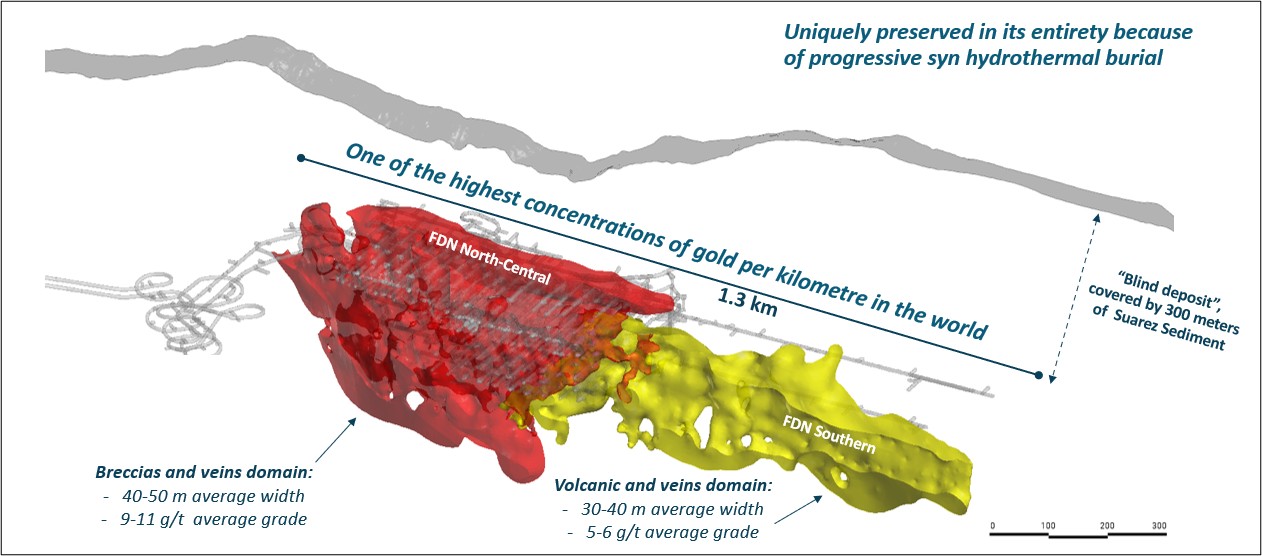Exploration
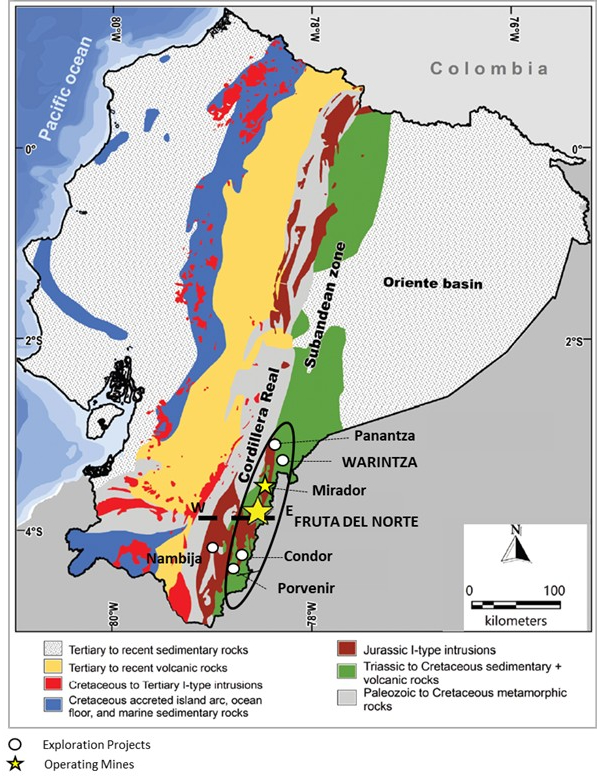
REGIONAL GEOLOGY
Fruta del Norte is situated in Ecuador within the Zamora copper-gold belt, nestled in the Cordillera del Condor, which forms the eastern foothills of the Andes. This location is recognized as a significant geological setting for major porphyry and epithermal systems.
Remarkably, this region has yielded major discoveries in just 20 years of exploration, establishing itself as a new and promising frontier for high quality mineral deposits within the Andes.
(*Image - Simplified geology of Ecuador, showing the location of the Fruta del Norte deposit and morphotectonic provinces adapted from INIGEMM, 2015)
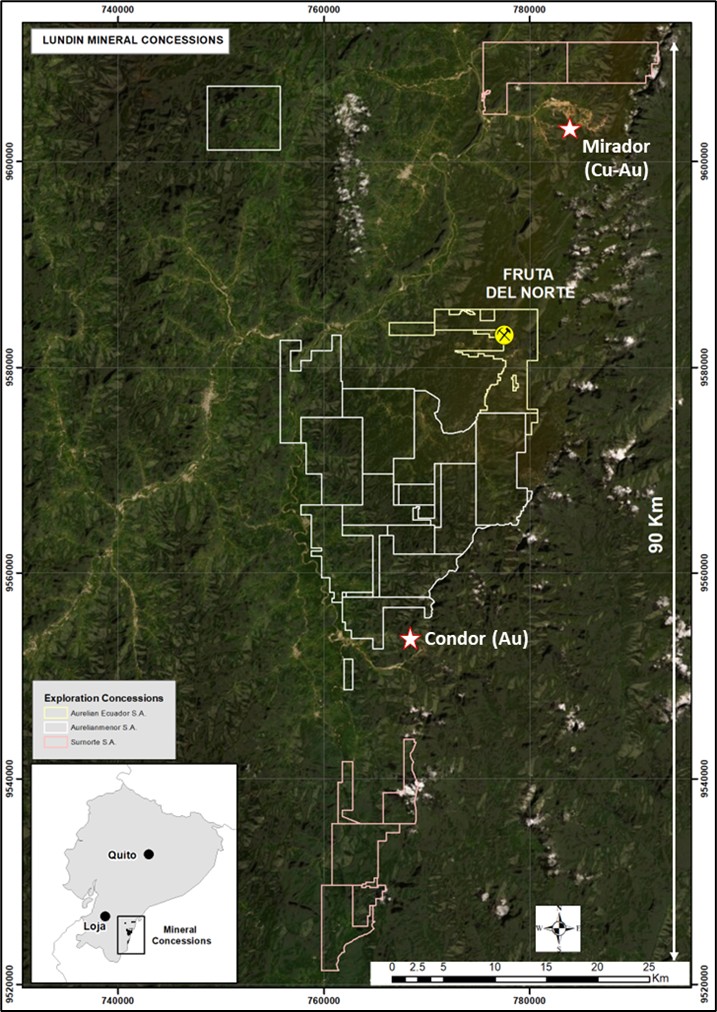
EXPLORATION CONCESSIONS
Lundin Gold possesses a substantial land package comprising 30 concessions that span 64,300 hectares along a 90 km north-south trend, situated within a highly prospective geological environment. This strategic land position potentially covers a corridor that hosts three major mineral deposits. Historically, exploration drilling has been concentrated in only one of these concessions, specifically around the area that is now the Fruta del Norte mine.
FRUTA DEL NORTE “FDN” DEPOSIT
Fruta del Norte, one of the premier gold discoveries of the last 50 years, is a large, high-grade, bulk-mineable, epithermal gold-silver vein-stockwork deposit.
The FDN deposit is located within a 150 km long copper–gold metallogenic sub-province located in the Cordillera del Cóndor region of Ecuador. The deposit is hosted by andesites of the Santiago Formation and feldspar porphyry intrusions.
The FDN deposit is a North-South trending intermediate-sulphidation epithermal gold–silver deposit measuring approximately 1,300 m along strike, 400 m down dip and generally ranging between 80 m and 300 m wide. The top of the deposit is located beneath approximately 200 m of post-mineralization cover rocks. The eastern and western limits of the deposit are defined by two faults that together form part of the Las Peñas fault system that is thought to control the gold–silver mineralization. The southern limit of the mineralization along the fault system has not been fully defined by exploration activities. The most intense alteration, veining, brecciation, greatest mineralogic complexity, and highest grades occur in the 300 m long, high-grade core, which contains most of the current Mineral Resource.
Mineralization is characterized by intense, multi-phase quartz–sulphide ± carbonate stockwork veining and brecciation over broad widths, typically between 100–150 m wide in the coherent central and northern parts of the system where the gold and silver grades are highest. Mineralized shoots are typically present within dilatant zones developed along inflections of vein strike or dip where the geometry permits maximum opening at the time of mineralization.
The mineralogy of FDN consists of chalcedonic to crystalline quartz, manganese-carbonates, calcite, adularia, barite, marcasite, and pyrite, as well as subordinate sphalerite, galena, and chalcopyrite, and traces of tetrahedrite and silver sulphosalts. The bulk of the gold is microscopic and associated with quartz, carbonates and sulphides. Much of the gold is free milling, but the mineralization is moderately refractory, with approximately 40% of the gold locked in sulphides. However, coarse visible gold is commonly observed. Individual gold grains range from discrete specks less than 0.1 mm in size to broccoli-like, arborescent crystals >10 mm across. Visible gold occurs in all mineralized zones, in quartz or carbonate, as well as within pyrite or silver sulphosalt clusters.
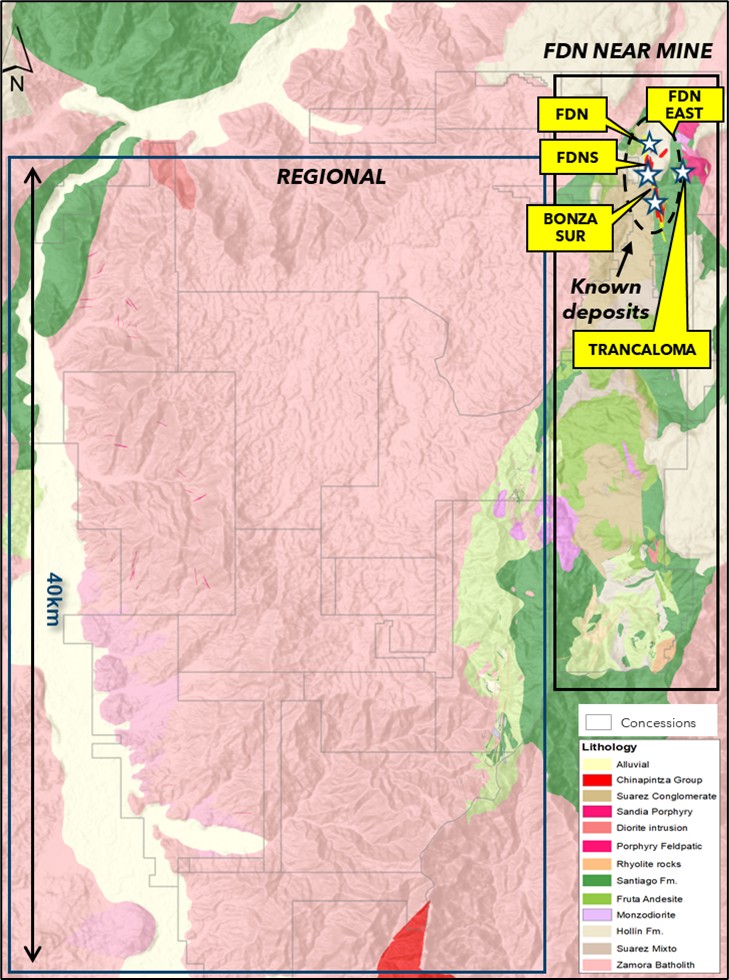
EXPLORATION STRATEGY
Lundin Gold’s exploration strategy consists of three main activities.
CONVERSION DRILLING
Replace depleted ounces and grow reserve base through conversion of inferred resources.
NEAR-MINE PROGRAM
Grow inferred resources through extension of known deposit and identification of new targets including FDNS, FDN East, Bonza Sur, and Trancaloma.
REGIONAL PROGRAM
Develop long-term gold inventory through exploration on untested sectors targeting new discoveries – looking for large epithermal systems like Fruta del Norte.
2025 is the first year of a three year program to identify new targets for drilling.
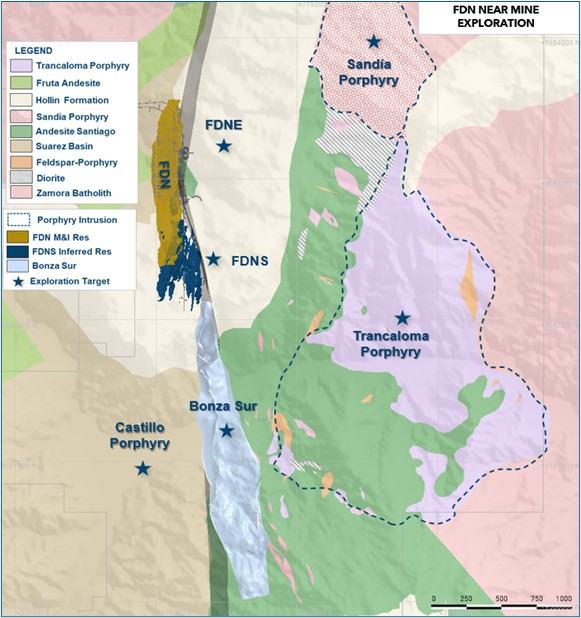
NEAR-MINE PROGRAM
FDNS: The FDNS deposit is a buried epithermal vein system recently defined across the southern limit of FDN.
FDN East: A buried epithermal mineralized system. Mineralization of similar hydrothermal & mineralogical characteristics and hosting rocks to those found at FDN and FDNS.
Trancaloma, Sandia, and other porphyries: Trancaloma and Sandia are porphyry systems - large, low-grade, hydrothermal ore deposits characterized by disseminated copper and gold mineralization from surface. Enhanced prospectivity around FDN suggests potential for other near mine porphyry targets.
Bonza Sur: Bonza Sur is interpreted as a shallow, disseminated gold-silver epithermal system situated east of the East Fault, a critical structural control at FDN.
Other: Pursuing scout drilling on other high priority targets.
Qualified Person
Technical information relating to Lundin Gold’s exploration activities contained on this website has been reviewed and approved by Andre Oliveira, P. Geo, Vice President Exploration of the Company. Andre is a Qualified Person under National Instrument 43-101.

